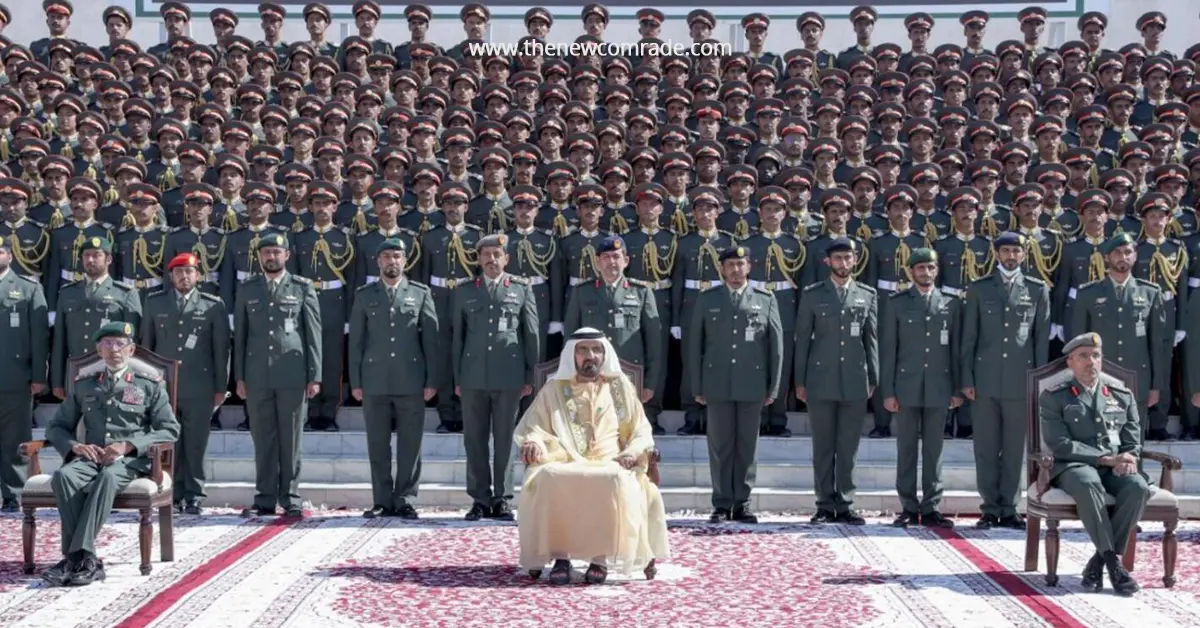With emergence of UAE in last decade as a regional player and a key US ally, several signs of its efforts to become a hegemonic power by extending its influence in the region, stretching from Arabian Gulf to Red Sea, Horn of Africa and beyond, have been revealed in parallel with its leading role in the fight against Muslim resurgence movements in West Asia and North Africa (WANA). Its continuous involvement and meddling in the counter -revolutionary efforts in Egypt, Libya, Yemen, and Sudan (just to name a few) have been well documented. It is in this context, therefore, that it has become imperative to investigate origins and evolution of UAE’s military.
This article explores rise and formation of UAE, the way its centralized authority governs it, Abu Dhabi’s particular strengths in comparison to the other six emirates in the union. It also examines the stages in which the UAE’s armed forces developed, especially in the aftermath of the spread of the uprisings across the region in 2011. These developments include establishment of Presidential Guards in 2011, mandatory military service from 2014 for Emirati citizens, introducing position of “Minister of State” for Defense Affairs in 2016. Moreover, this article attempts to explain UAE’s increased military spending, growth of UAE’s defense industries, most prominent companies in this field, etc. It tries examining most significant foreign military ventures, along with the presence of foreign militaries there.
This study discusses Emirati military’s prospects, considering its strengths, weaknesses, and regime’s aspiration to become a regional hegemony. While UAE has been a principal partner within a regional alliance formed to undermine aspirations of millions of citizens of Arab states in their attempts to establish free and democratic representation across the region, this aspect of the UAE’s geopolitical strategy is only partially touched upon in this study.
Establishment of United Arab Emirates in 1971
For centuries, Qawāsem tribe lived on the coastline of northeastern Arabian Gulf and the Gulf of Oman, while Banī Yās tribe inhabited desert areas around villages bordering Līwā oasis. In 1761, the chieftain (sheikh) of Bū-Falāḥ clan (to which Al-Nahyān belongs) of Banī Yās, moved to Abu Dhabi island after discovering fresh water there. In the early 19th century, several members of the Bū-Falāsa clan, also from Banī Yās, settled in the Dubai Khor (creek) and established the rule of Al-Maktoum family in the emirate of Dubai.
As the Portuguese began exploring sea routes between Europe and India, European fleets started to arrive in the Arabian Gulf by 16th century and assert their dominance over navigation and control of transportation to India. Portuguese and Qawāsem – current rulers of emirates of Sharjah and Ras Al-Khaimah, fought fierce battles. Britain replaced Portugal in the 18th century as the main aggressor in that region, as they were concerned with strengthening their naval power in Arabian Gulf and excluding other European powers in the course of it. Between 1809 and 1819, several wars took place between the British and Qawāsem ending with a British victory and the destruction of Ras Al-Khaimah, Ajman, Sharjah, and Umm Al-Quwain, as well as parts of Dubai.
After the defeat of Qawāsem, Britain made a series of agreements during the 19th century with Sheikhs of the coastal emirates. Thus, the area comprising Abu Dhabi, Dubai, Bahrain, Qatar, Ras Al-Khaimah, Umm Al-Quwain, Ajman, Sharjah, and Fujairah became known as Trucial Oman. Under those agreements, the Trucial Sheikhdoms had to ensure security of navigation in Arabian Gulf, refrain from building large ships, constructing fortifications along the coast, pledge not to enter into agreements or make contact with any force or country other than the British in exchange for their “protection”. As a result, Britain effectively controlled foreign and defence affairs of Trucial Oman. In 1902, these terms were extended to pledges of not to trade in arms, and further in 1922, to not grant any concessions for oil exploration without its prior consent.
At that point in time, the region’s economy relied heavily on fishing, exporting dates, and pearl diving. Pearl trade suffered a heavy blow at the end of 1940s following British Indian government’s decision to impose heavy taxes on pearls imported from Arabian Gulf. Japan’s development of cultured pearl further contributed to decline of Arabian Gulf pearl trade in 1946 to the equivalent of GBP 250,000, after it was estimated at GBP 15 million in 1925. A breakthrough occurred with the discovery of oil in Trucial Emirates. The first shipment of crude oil from Abu Dhabi was in 1962, and from Dubai in 1969.

Until mid-20th century, Abu Dhabi was a poverty-stricken emirate. In 1965, Abu Dhabi island had a population of mere 4,000 inhabitants. Britain considered it only third in importance as a stop on the coastline, lagging behind Dubai and Sharjah. London managed its relations with Abu Dhabi through its political representative in Dubai, until 1955, when Britain appointed a British political officer in Abu Dhabi that would report to their representative in Dubai. By 1961, Britain had inaugurated, in Abu Dhabi, a political agency reporting directly to British “resident” in Bahrain as a sign of increasing importance of Abu Dhabi owing to its then recent oil discovery.
With rise of Arab nationalist tide in 1950s and 1960s, and emergence of leftist groups in the region, Britain worked to re-engineer political setup in Arabian Gulf. Specifically, it sought to defeat the liberation movement of Dhofār that was supported by the communist government of South Yemen and the Soviet Union. In 1965, Britain supported a coup that overthrew the Pan-Arab ruler of Sharjah, Saqr bin Sultan Al-Qāsemī, after he refused to renew the agreement to extend the lease of RAF base in Sharjah. London viewed him as an irritant with suspected ties to Iraq, as well as Nasserite Egypt, where he was exiled to.
In 1966, London also orchestrated Zayed bin Sultan Al Nahyan’s (1918-2004) overthrow of his brother Shakhbūṭ, ruler of Abu Dhabi, on the pretext that Shakhbūt’s rule was stagnant and hindered oil and gas projects carried out by British companies, and that more flexible rulers would help in economic and social policies that would shield the region from penetration of leftist groups.

By National Archives of the United Arab Emirates, Ministry of Presidential Affairs
After World War II, the British generally avoided waging direct bloody wars in its colonies unlike France, which had fought in Algeria and Indochina (Vietnam). In January 1968, London announced its intention to withdraw all military forces from regions to the east of Suez Canal, which included Arabian Gulf region, by the end of 1971. London rejected the offer made by rulers of Dubai and Abu Dhabi to pay Britain’s costs, approximately GBP 12 million annually, for its military presence in the Gulf.
Prior to its withdrawal from Arabian Gulf, Britain worked upon the best way to guarantee that its interests were protected by uniting Trucial Emirates (Abu Dhabi, Dubai, Qatar, Bahrain, Ras Al-Khaimah, Ajman, Umm Al-Quwain, Sharjah, and Fujairah) to form an entity that would prevent Soviet penetration into the region and limit Iran’s expansionist ambitions. Sheikhs of the emirates held consultative meetings starting in 1968, culminating in an agreement to appoint Emir of Abu Dhabi, Zayed, as President of the Union for two years and then Crown Prince of Qatar, Khalīfa bin Ḥamad, at the head of a federal cabinet, to which each emirate nominates its representatives.
However, there were disagreements regarding each emirate’s slots in federal cabinet, rates of contribution to the federal budget, choice of capital, etc. Disagreements regarding representation revolved around if it would be equal for constituent emirates or determined by each emirate’s population. Bahrain wished to be represented proportionate to its population, since it had a population of over 200,000 at the time, more than the rest of the emirates combined, while smaller emirates such as Ajman, Fujairah, and Ras Al-Khaimah wished for equal representation regardless of population size. Consequently, Bahrain withdrew from those negotiations, with US support, and declared independence in August 1971, followed by Qatar in September. Initially, the ruler of Ras Al-Khaimah refused to join the union due to constitutional provisions that required consent of Dubai and Abu Dhabi for all federal decisions. However, six emirates did agree to unite: Abu Dhabi, Dubai, Sharjah, Ajman, Umm Al-Quwain, and Fujairah). The establishment of the United Arab Emirates was thus announced on December 2, 1971, with a population of 180,000 citizens.
Three Islands’ Problem
On November 30, 1971, one day before announcing the abolishment of the British protection treaties and two days before announcing establishment of UAE, Iranian army took control of Greater Ṭunb and Lesser Ṭunb, two islands belonging to Ras Al-Khaimah, which was not yet in the union. The ruler of Sharjah was also forced to sign an agreement with Iran to share the administration of Abū Mūsā island in November 1971. Following Ras Al-Khaimah’s realization of the challenges it would face were it to remain alone, it joined the Union on February 10, 1972.










